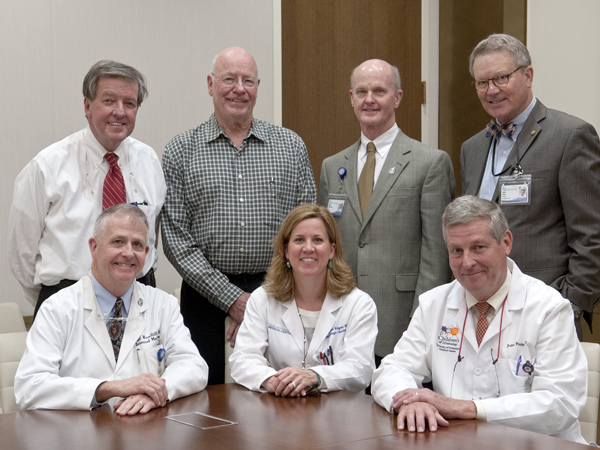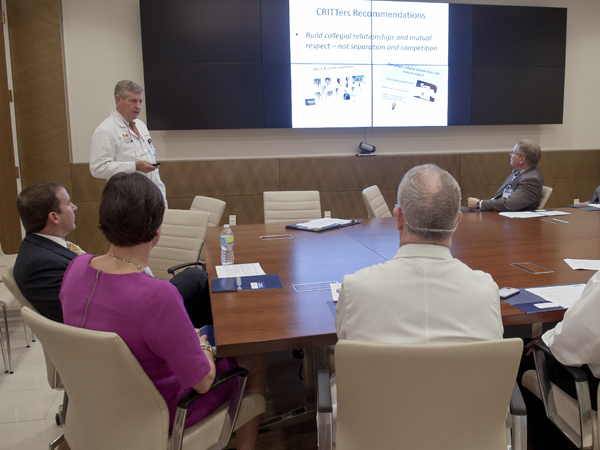‘CRITTers’ initiative bridges breach between town and gown

MARCH 25 ATTENDEES
- Dr. James Keeton, special advisor to the vice chancellor for health affairs
- Dr. Charles O'Mara, associate vice chancellor for clinical affairs
- Dr. John Purvis, associate professor of pediatric orthopedics
- Dr. Mart McMullan (by phone), senior advisor to the vice chancellor
- Dr. Bryan Barksdale, professor of medicine in the Division of Cardiology
- Dr. Mildred Ridgway, assistant professor of obstetrics and gynecology
- Dr. Jim Sones, professor of medicine and chief of the Division of Digestive Disorders
- Dr. Dan Woodliff, associate professor of medicine, internal medicine
- Kevin Cook, CEO, University Hospitals and Health System
- Guy Giesecke, CEO, Children's of Mississippi
- Dr. Mechelle Keeton, director, Office of Physician Relations
- Kate Feldman, physician liaison, Office of Physician Relations
In the medical world, there can be a persistent, prickly relationship known as "town vs. gown" - academic vs. private practice medicine, university physicians vs. community doctors.
Between the institutions and the surrounding community, the distinction, and possibly the mutual suspicion, has been around for ages - at least as far back as the medieval period, when university students and teachers wore scholars' gowns that distinguished them from the other townspeople.
One of the most divisive issues, at least today, involves patients - who cares for them and where.
Recognizing that this type of competition is not always healthy, the Medical Center is trying to shrink this rift through the efforts of a committee that met again last month and bears the acronym, CRITTers.

"Our goal is to convert "town vs. gown" to "town and gown," said Dr. John Purvis, associate professor of orthopedics, and a member of the Vice Chancellor's Ad Hoc Committee for Community Relations Improvement.
CRITTers, which held its first meeting in August 2013, reconvened on March 25 for an annual reunion and to hear the results of its effort to restructure the Office of Physician Relations, now led by Purvis.
Dr. James Keeton, who recently stepped down as vice chancellor for health affairs and dean of the School of Medicine, mandated the CRITTers initiative.
"Dr. Keeton charged us as a group to serve as a kind of community relations improvement think tank, from which the acronym CRITTers evolved," said Dr. Charles O'Mara, associate vice chancellor for clinical affairs.
Made up of about a half-dozen faculty members who, like Keeton and O'Mara, were previously in private practice, the committee has met 10 times over several months to address the concerns of physicians working inside and outside the Medical Center. Other UMMC faculty members and administrators also met with the committee to consider improved community relations in research and training, as well as in clinical care.
The community physicians, of course, frequently refer patients to UMMC. One of the top things these referring physicians want, Purvis said, "is to get their patients back."
Although not universal, such tension between private practitioners and the clinical faculty of the medical school has existed to some degree in Mississippi since 1955 with the establishment of the four-year medical school in Jackson.
The complaints are not unique to the Medical Center. Primary care physicians nationwide have protested that the patients they send for specialized care to academic hospitals often stay there.
For their part, academic medical centers must have some private patients to balance the large number of those who are in need.
It's important for academic medical centers to offer quaternary care - highly specialized procedures and uncommon surgeries, Purvis said. "But it's also important for trainees to help care for those patients who do not require unique specialty care.
"And it's not just about competition for patient care and the finances involved with that; it's also about how town and gown can collaborate in research opportunities and in training health-care students."
As long ago as 1987, the president of the Association of American Medical Colleges called for a nationwide truce between the factions, saying, "Only if the town and gown stand together will the best in private practice and academic medicine be preserved."
The rivalry for patients has only escalated since then, even in Jackson.
"Relations between the University Hospital and private physicians kind of got rocky in the last five to 10 years," said Dr. Rick Guynes, cardiologist with Jackson Heart and chief of staff at St. Dominic Hospital.
CRITTers and the Office of Physician Relations at UMMC, he said, represent "an effort to start mending some of those wounds."
Guynes is among the physicians outside the Medical Center who have met with members of the committee, which has also explored the inconsistency of follow-up letters or phone calls once patients are referred, and the need for communication about patient care in general.
"We have discussed using emails and texting with town physicians in emergencies, but being careful not to violate HIPAA," said Dr. Dan Woodliff, UMMC associate professor of medicine and CRITTers member.
Asked to comment on progress so far, Guynes, the St. Dominic physician, said, "It's too soon to gauge.
"But because the Medical Center is reaching out, the situation is better now; they're coming across as more collaborative.
"Most of us trained there. Many physicians have children who are training there right now. So we want the Medical Center to be a strong partner, a facility that we are all proud of.
"Anything we can do to improve patient flow, information flow, getting records quickly from us to them and from them to us, improves patient care, which is what it's all about anyway."


